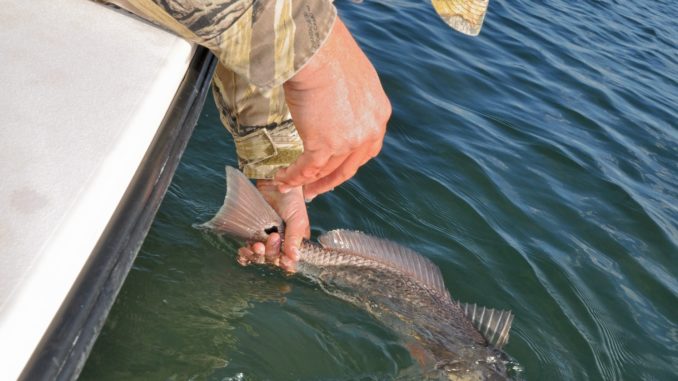
Cold weather will push some redfish into ocean, but marshes still provide action
December usually marks the beginning of winter weather along North Carolina’s coast, as falling water temperatures force nearly all baitfish into the ocean — along with gamefish that eat them.
Except for one: red drum.
A significant number of winter reds, from under- to over-slot, remain in inland rivers, creeks and saltwater bays such as those from Harkers Island to Beaufort, Morehead City and points south.
Large red drum schools patrol ocean waters just behind the breakers until hard freezes force them offshore or to southern beaches. At that point, the problem for fishermen won’t be enticing reds to bite, but water clarity and sometimes porpoises.
The winter water becomes gin clear, and anglers must be careful not to spook reds with unnecessary movements and noises.
Although porpoises are deadly enemies of red drum, they also provide a service by forcing reds into shallow water where they’re easier to spot and will take scented soft-plastic jigs, bait chunks and flies.
One of the best at catching winter reds is Joe Shute, the owner of Atlantic Beach’s Fish Finder Charters and Cape Lookout Fly Shop (252-240-1427).
“I think November, December and January are the three best months to fish for reds,” Shute said. “I’ll fish for them all day; the tide doesn’t make much difference. I do like sunny days. It seems when the tide’s a little lower in the middle of the day, they get a little more active.”
Shute is one of the state’s most-expert saltwater fly anglers; he likes to take clients who can use a long rod, but he also guides anglers who prefer baitcasting and spinning tackle.
“I think reds like darker-colored flies in winter more than any other time,” he said. “I fish dark color combinations — orange-and brown, black with gold flash, gray-and-white and sometimes black-orange-gold seem to work.”
His flies are basic Clouser and baitfish patterns, although sometimes he’ll try a small crab pattern with No. 2 hooks.
“I normally use a 7- or 8-weight rod in the marsh and an 8-weight in the ocean,” Shute said. “A No. 8 is the best all-around rod.”
He uses floating line in the sound and switches to an intermediate sinking line if reds are 3 or 4 feet deep.
“You can find 50 to 200 fish sometimes stacked up in little bays,” Shute said. “If they’re coming at me, I sit and watch them until they either turn away or go past me, then I try to cast in front of them.”
When he fishes the ocean, he expects more and quicker bites because of a lack of bait in the water.
“Reds will be hungry, and it makes them very aggressive,” Shute said.
Weather must be nearly perfect — little to no wind — to fly-fish in the ocean, so his anglers usually cast 4- to 5-inch Gulp or 4-inch Edge paddletail minnows in light green on 1/4- to 3/8-ounce jigs. If Shute uses a MirrOlure, he’ll swap out factory treble hooks for single hooks.


Be the first to comment